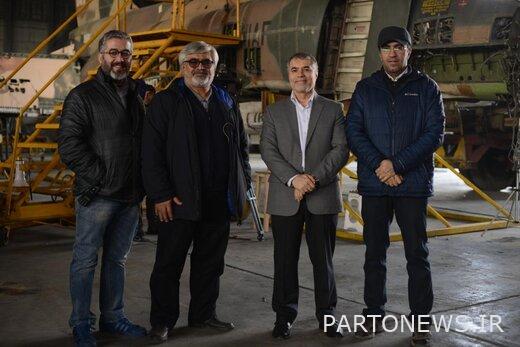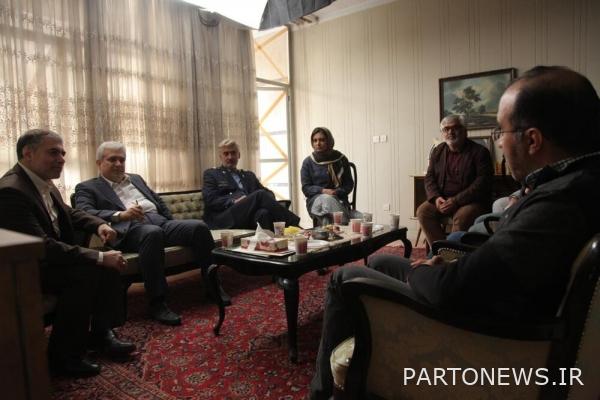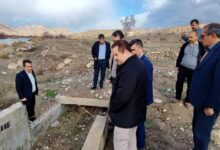If the late Hashemi was alive, he would not have allowed his role to be removed from “Mansour”

The screenwriter and the person in charge of researching the film “Mansour” talks about how this work was made and the importance of its production.
Theater News Base: The movie “Mansour” directed by Siavash Sarmadi and produced by Jalil Shabani is a production of Ouj Media Arts Organization, which has been released in cinemas all over the country since November 10th.
This film is a slice of the life of Martyr Mansour Sattari, Commander of the Air Force of the Islamic Republic of Iran. A commander who held this position from 1986 until his martyrdom in January 1994 and was the source of many services in the Air Force.
For this reason, in an interview with Parviz Karami, consultant and head of research on the script of “Mansour”, we examined how Mansour’s film was made and its importance.
In addition to years of public administration in various fields of cultural, scientific and media, Karami is the Secretary of the Office of Soft Technologies and Creative Industries Development of the Vice President for Science and Technology and the Head of the Executive Office of the National Document for the Development of Cultural and Soft Technologies. The president’s technology has been introduced as the head of the vice president’s office.
Karami said about his acquaintance with Martyr Sattari and the “Mansour” project: “My acquaintance with Martyr Mansour Sattari goes back to my cooperation with his son, Dr. Sorena Sattari, Vice President for Science and Technology in the previous government.” When Dr. Sattari became the scientific assistant in 1392, I met him for the first time. However, due to my background in the front, I knew Martyr Sattari as the commander of the Defense and Air Force, who was martyred in a plane crash, and I had heard from a group of Air Force commanders that he was one of the good and prominent commanders of the Defense and Air Force. The air force was the army of the Islamic Republic of Iran.
The website that paved the way for the production of a movie
He stated: “Some meetings and events led to a greater and deeper knowledge of General Mansour Sattari.” In January 2013, I participated with Dr. Sattari for the first time in the anniversary ceremony of Martyr Sattari at the Air Force University, which was held by the Air Force and Air Defense of the Army of the Islamic Republic of Iran in the presence of a group of former and former Air Force commanders and fellow martyrs. In that ceremony, in addition to the memories and mentions of the martyr, a few clips of the documentary Martyr Sattari made by Mr. Mohammad Ali Farsi from his life were shown, and I just met a person whose society was unaware or unaware of the capabilities of his initiatives and services. Be a good role model for the good youth of the country
Mansour Screenplay Advisor added: On the way back from the ceremony, I told Dr. Sorena Sattari that I and my colleague (Innovation Technology Monthly) are willing to design a site for the martyr without any hesitation and information, documents, including photos and scattered videos of him. Collect and present there on the site. Mr. Doctor accepted, and this led me to do more research on this martyr during non-business hours and in my spare time. I requested information and documentation from Mr. Doctor, and Mr. Doctor provided me with a collection of documents, including VHS films and two available Betamax films, as well as notebooks and memoirs, and anything that could be said in public about Martyr Sattari. I slowly saw that the documents I have have a capacity beyond a site, and this made me think of a special work about the martyr.
Karami continued: “During my research, I found out that Martyr Sattari was a brave man, a creator, an innovator, and an Iran-Islamist, a media writer, a lover of the Ahl al-Bayt, and a very prolific man.” On the other hand, he had initiatives in the war and the length of the holy defense and self-sufficiency jihad, and with the same initiatives in the field of radars and air defense during Operation Valfajr eight, he had shot down eighty state-of-the-art aircraft of that time in one week.
From “Ouj 110” to “Mansour”
He stated: On the second and third anniversary of the martyr, I became more acquainted with his friends and comrades. In these ceremonies, we had prepared and published special letters to introduce this martyr. Coincidentally, under the name of “Mansour”, I suggested to my good friend Siavash Sarmadi, who had a history of collaborating in several documentaries, to make a documentary about one of the stages of the martyr’s life, about how to make the first series of fighters known as the “Peak 110” project. Which was related to Parasto training aircraft, training jet and Azarakhsh fighter.
He added: “During his command, Martyr Sattari built a light training aircraft called” Parasto “and a training jet with the aim of using it in training in the Air Force.” At the same time, in addition to working on overhauling and overhauling the fighter aircraft and the 100-aircraft project, they commissioned the construction of the Azarakhsh fighter aircraft, which was called the 110 peak project. When we first talked to Mr. Sarmadi about making the documentary, it was decided that I would be involved as a researcher and consultant, and that Mr. Sarmadi would be in charge of writing and directing.
Karami stated: During the writing and performance of this documentary, Mr. Sarmadi consulted with various friends of directors and individuals. In the end, our friends at the Ouj Institute suggested to Mr. Sarmadi to make a film and not a documentary about it. Siavash raised the issue with me. I also welcomed this proposal very much, and finally, with the proposal of Ouj Organization, the form of writing the script and performing the work was changed. And now, three years after the completion of the work, the title of the film was changed from “Avaj 110” to “Mansour” and was released in cinemas.
Karami stated: During this project, we will get acquainted with Martyr Sattari, who was the crystallization of love for God and the revolution of the Imam and the leadership and Iran. Mansour’s film is a slice of life full of the efforts of initiatives and struggles and the story of a hero who was disappointed by the problems and shortcomings of the time and even the approach of some officials of the time to say that it has nothing to do with me, we can not and can not believe in ” “We can,” he tried. Like Martyr Sattari, we have many heroes. These days coincide with the anniversary of the martyrdom of Hassan Tehrani, the forerunner of the father of missiles and the authority of the country, who were mystical heroes and prodigies in missile and defense development. Like Shahid Sattari, he has worked in the field of our missile and defense industries. When many said “no” he said “we can” and he could, and these men and national heroes, from a situation where we did not have barbed wire and even ordinary bullets, led us to the most advanced ballistic missiles, the strongest defense missiles and launching satellites and fighter jets. We have not been given cruel sanctions.

“Awj” sincerely stood at the feet of “Mansour”
Karami emphasized: Our national heroes are Martyr Sattari, Martyr Hassan Tehrani, Moghaddam, Haj Ghasem Soleimani, each of our martyrs such as Kazemis, Boroujerdis, Dastareh and all, Saeed Toghanis. There is a world of real heroes and myths in front of us, but unfortunately, the shortcomings and drowsiness of those in charge have caused these myths and symbols of “we can” to be neglected in society and our youth to turn to false Western myths. We have great myths, for example, the martyr Saeed Toughani, the little hero of Iran, who can be a good myth for our teenagers and youth. Why not create content about these? I have to thank the Ouj Cinema Organization for its efforts and for its honest and sincere work.
He added: “These days, the Ouj organization is the target of criticism that due to its affiliation with the IRGC and the Basij, it only makes films about IRGC characters.” But Ouj Organization selflessly and sincerely supported Mansour’s film, which is related to one of the country’s military heroes, and stood from zero to one hundred. Because I was with the production team, I saw the difficulties of the work, such as the coordination of entering the barracks and the structure of the army, given the developments in the region and the sensitivities of the work.
If Hashemi was alive, he would not have allowed his role to be removed from “Mansour”
He explained about the margin of deleting parts related to Hashemi from this film: Deleting this sequence will damage the film. Mr. Hashemi played a positive role during the film. I do not know why the family of the late Hashemi opposed it. In this sequence, Martyr Sattari goes to the parliament and there is a conversation between him and Mr. Hashemi that Hajj Agha, you supported us, but I must have the budget to be able to fulfill the obligations of the personnel and engineers and so on. Mr. Hashemi supports and accompanies Martyr Sattari. I think if Mr. Hashemi was alive, he would not have objected to showing this scene and would not have allowed his role to be removed from “Mansour”. Mr. Hashemi’s spirit was such that he was accompanied by initiatives and innovations. As a fan of Mr. Hashemi, when I saw this film, I did not have a negative impression, either in terms of content or structure.
“Hope is the highest blessing for human beings,” Karami said in a recommendation for the film. Having hope, trust and effort causes man to go through the hardships, hardships and sufferings of life. Every individual, society and nation that loses hope is destroyed. This film shows us how at the height of adversity, hope leads to victory. If young people want to see how belief and hope can be fruitful, they should watch this film.

